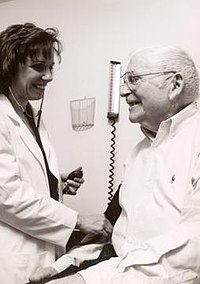
Photo from wikipedia
Dear Editor, We wish to share our research on characteristics of a professional as defined by primary care and non-primary care residents and link our results to speculations on how… Click to show full abstract
Dear Editor, We wish to share our research on characteristics of a professional as defined by primary care and non-primary care residents and link our results to speculations on how this might mitigate interdepartmental incivility (bashing). Bynum and Lindeman describe the phenomenon of ‘interdepartmental mistreatment’ as ‘lack of civility between departments’ with the result being that students ‘may buy into interdepartmental stereotypes and mimic them ... further propagating the culture of disrespect’.[1] Primary care and psychiatry are the specialties most often the targets of incivility, disrespectful language and bashing.[2,3] Ajaz [2] found that 93% of students hear negative comments towards another specialty at some point in their training and that students’ hearing more negative comments was strongly associated with students’ making more negative comments. They accept it as ‘a bit of harmless fun’ and ‘part of the culture of medicine’. Nevertheless, many medical students are distressed by hearing interdepartmental incivility and struggle about how to respond. We found a remarkable description of interdepartmental mistreatment and a student’s reaction in a reflective practice essay from one of our paediatric clerks: ‘Over my hospital rotations one thing has bothered me more than anything, the prevalent undercurrent of disrespectful interpersonal interactions between staff members, the hubris of medicine’s nasty side’.[4] Overhearing negative comments or incivility by residents and faculty has several ill effects. Students may change their choice of specialty.[2] They may participate in the uncivil behaviours in an attempt to fit in with the team. [1] Students may repeat the behaviours and acquire the habit of hostility over time.[5] Students may also become disheartened with the practice of medicine and lose the ability to empathise with their patients.[6] Medical students are unlikely to speak up when they witness unprofessional behaviour. Unfortunately, they are more likely to assimilate negative behaviours [1,7] and find them culturally acceptable. We sought to explore what it is about the culture of medicine that promotes interdepartmental disrespect that is often directed to primary care specialties. Specifically, we hypothesised that there may be a difference in how medical professionals from primary care and non-primary care specialties define ‘professionalism’ which might lead to perceived ‘otherness’. Following IRB approval, we surveyed 1148 physicians in Graduate Medical Education (GME) at two institutions, asking them to free-text three characteristics of a professional. SurveyMonkey© was used to develop the tool, which was distributed by email. Responses were voluntary and anonymous. Two researchers, working independently and blinded as to the year group and specialty of the trainee, used the grounded theory approach in qualitative analysis to code over 700 free-texted responses and assign each response to one of 14 themes (characteristics). The researchers discussed differences in the themes for each free-texted characteristic until resolution was reached. Our theme ‘patient-first’ included responses such as ‘selfless’, ‘dedication to one’s patients’, ‘habitually putting the patient first’, ‘humanism’, ‘primacy of patient care’, and ‘caring’. Our ‘life-long learning’ theme included responses such as ‘knowledgeable’, ‘knowing limitations’, ‘self-education’, and ‘dedication to one’s field of practice’. The response rate was 29% with 137 participants from primary care residencies (family medicine, internal medicine, pediatrics) and 124 from non-primary care residencies (surgery, surgical subspecialties, obstetrics, emergency medicine, pathology, anaesthesia, etc.) Themes found in over half of each group were patient-first and lifelong learning characteristics. Honesty, diligence, integrity, communication, maturity and accountability/responsibility were also listed. The lists of professional characteristics described by both groups were nearly identical (Spearman coefficient 0.87). Figures 1 and 2 are word clouds that illustrate the results. Word clouds represent the frequency of a word using the size of the font. More frequent words are in larger fonts. This study reveals common ground, rather than differences, between the primary care and non-primary care residents. The groups of residents listed the characteristics of a professional with nearly identical frequencies and each endorsed patient-first and life-long learning as most important. Interdepartmental incivility based on
Journal Title: Education for Primary Care
Year Published: 2017
Link to full text (if available)
Share on Social Media: Sign Up to like & get
recommendations!